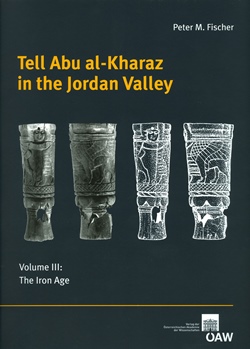


Tell Abu al-Kharaz, ein Siedlungshügel im mittleren Jordantal, östlich des Jordans, wurde zwischen 1989 und 2012 unter der Leitung des Autors erforscht. Die Stadt erlebte ihre Blütezeit in der Frühbronzezeit und – nach einer längeren Besiedlungslücke – in der späten Mittelbronze- und der Spätbronzezeit. Als letzter Band in einer Serie von drei Bänden über Tell Abu al-Kharaz (Band I: Frühbronzezeit, 2008; Band II: Mittel- und Spätbronzezeit, 2006) ist das vorliegende Buch der erste abgeschlossene Bericht über eine eisenzeitliche Siedlung im Jordantal. Ausgrabungs- und Bearbeitungsmethoden werden in Kapitel 1 beschrieben. Kapitel 2 präsentiert die Stratigraphie, die gemeinsam mit der Architektur, der Keramik und den Kleinfunden behandelt wird. In Kapitel 3 werden die Typologie und Chronologie der keramischen Funde, einschließlich der zahlreichen Importe, beschrieben und sowohl typologisch als auch chronologisch klassifiziert. Kapitel 4 ist der Auswertung der 42 Radiokarbondaten gewidmet. Kapitel 5 schließlich beinhaltet eine Zusammenfassung der Resultate: Klima, Umwelt, Fauna und Flora, Art der Besiedlung, Anzahl der Einwohner und die mögliche Verwaltung der Stadt, Wirtschaft und Handel sowie die Handelswege. Die Architektur der sieben Siedlungen der Eisenzeit und die Keramik werden weiterhin diskutiert. Funde, die auf Kontakte mit den Philistern/Seevölkern schließen lassen, werden behandelt. Spezielle Aufmerksamkeit wird der relativen und absoluten Chronologie der Besiedlungsphasen mit Hilfe von Radiokarbon und dem Vergleich mit geeigneten Grabungsstätten gewidmet. In vier Appendices werden die Figurinen, ein außergewöhnlicher Handgriff aus geschnitztem Knochen, Schminkpaletten aus Stein und Alabaster sowie das glyptische Material und die Ostraka diskutiert.
Gedruckt mit Unterstützung des Fonds zur Förderung der wissenschaftlichen Forschung (FWF).

Tell Abu al-Kharaz is situated in the central Transjordanian Jordan Valley. The author directed the excavations of this settlement from 1989 to 2012. The town flourished in the Early Bronze Age, and after an occupational lacuna of more than thousand years the site was re-occupied in the second half of the Middle Bronze Age and remained permanently occupied until the end of the Iron Age. The new volume is No. III in a series of three (The Early Bronze Age Vol. I, published by the Austrian Academy of Sciences Press in 2008, and the Middle and Late Bronze Ages Vol. II, in 2006). Chapter 1 describes excavation and processing methods. In Chapter 2 the stratigraphy, the architecture, the ceramics and small finds are presented as an integrated part of the publication. Chapter 3 deals with the typology and chronology of the ceramics which include numerous imports. Chapter 4 is devoted to the evaluation of the 42 radiocarbon dates from Iron Age contexts. The general conclusion and discussion is in Chapter 5 which deals with discussions on the climate, type of settlement, number of people, administration, the seven settlement phases, architecture, pottery and small finds as well as trade and trade routes. There are finds that are unmistakably related to the Philistines/Sea Peoples which is unique for the Transjordanian Jordan Valley. Other finds are related to the Phoenician and Egyptian sphere of culture. Special attention is devoted to relative and absolute chronological enquiries based on the considerable number of radiocarbon dates and parallels from other sites. The four appendices deal with the figurines, a unique carved bone handle, cosmetic palettes of stone and alabaster and glyptic and ostraka.
Printed with the support of the Austrian Science Fund (FWF).
2014,
978-3-7001-7332-8
978-3-7001-7615-2
558 Seiten, zahlr. Abb., 6 Falttafeln,
30,5x23,5cm, broschiert